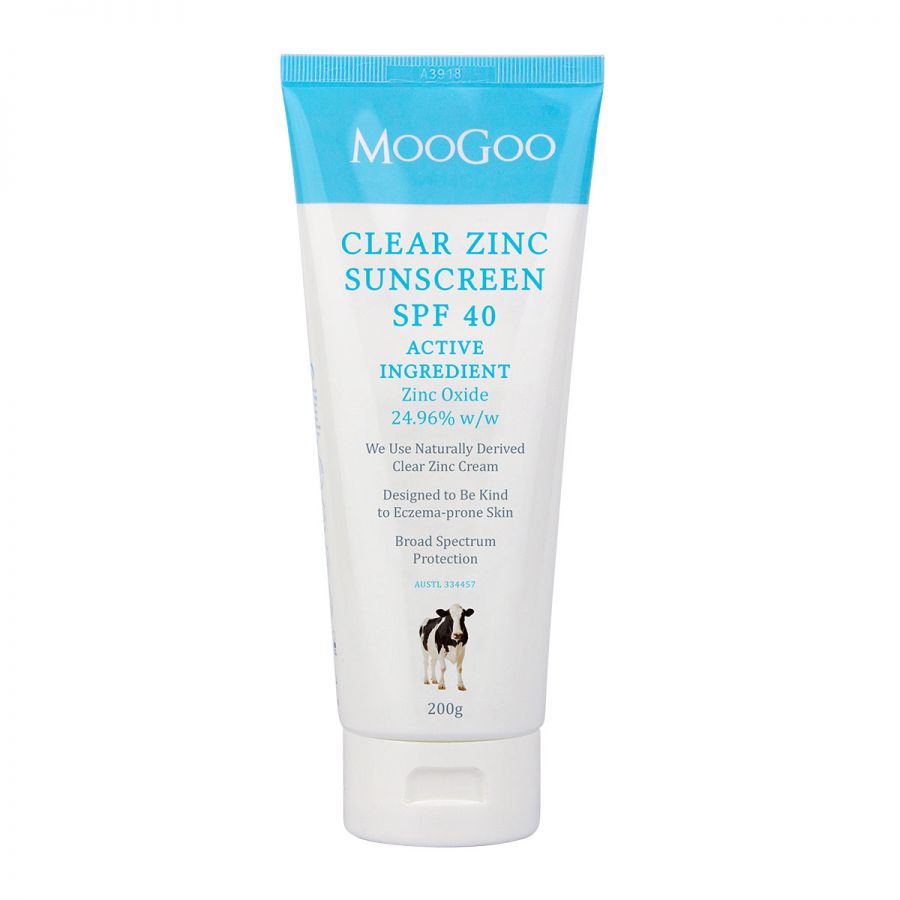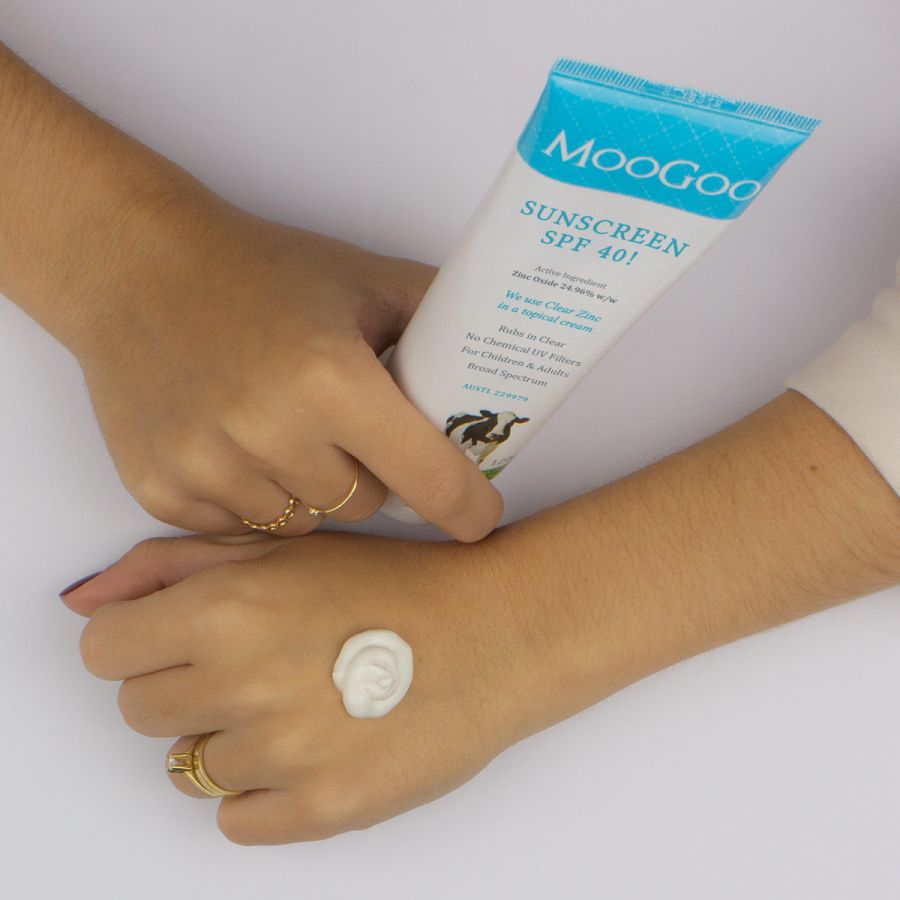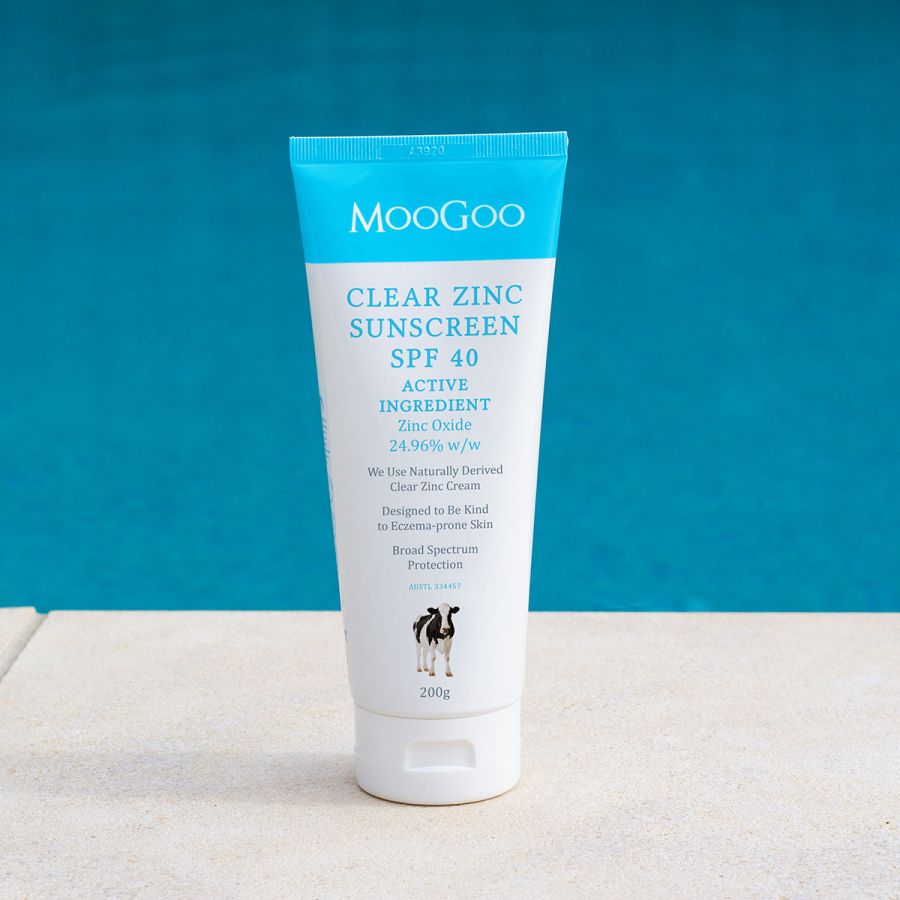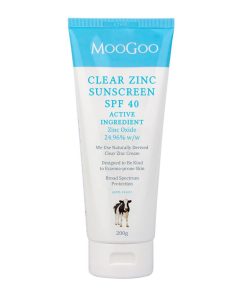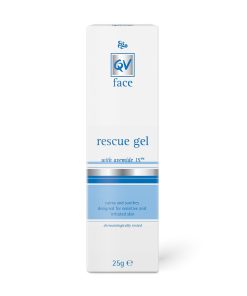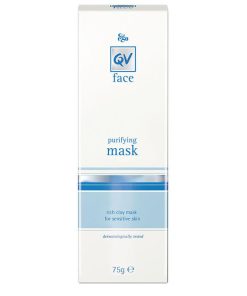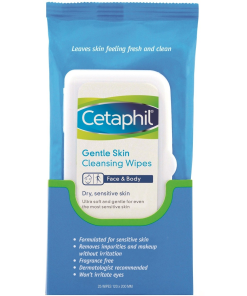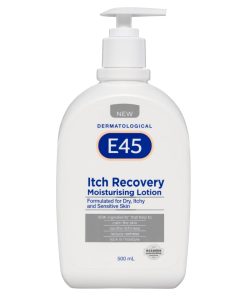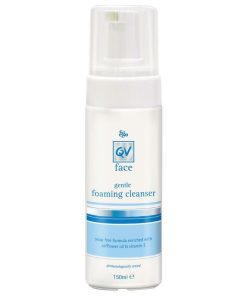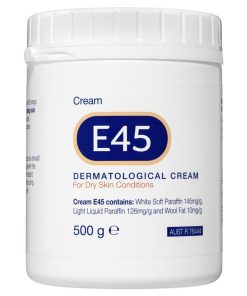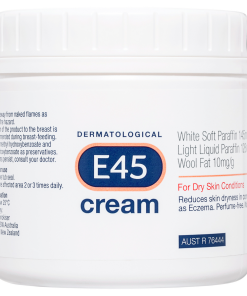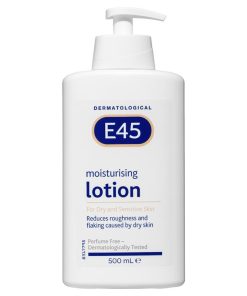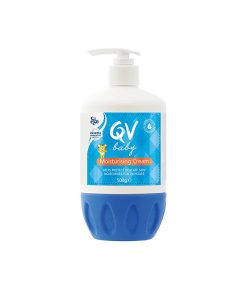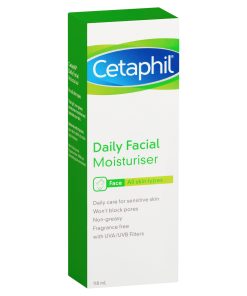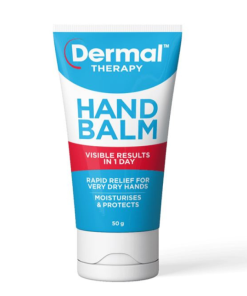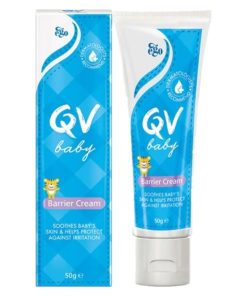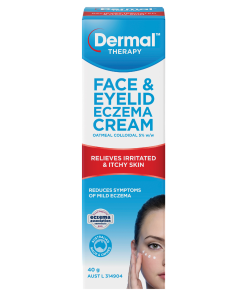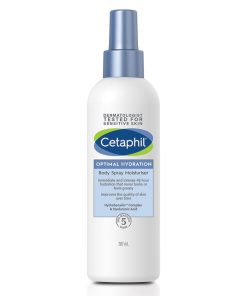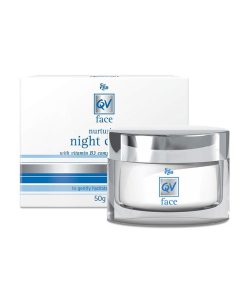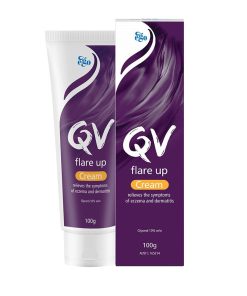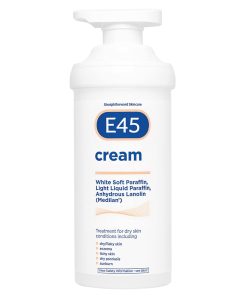MooGoo Natural Clear Zinc Sunscreen SPF40 200g MooGoo
$ 29,95 $ 17,97
We wish making a good sunscreen using only Zinc as the active was as easy as putting Zinc into a moisturiser; but it’s not. Developing a sunscreen with broad-spectrum sun protection using only Zinc, without being too greasy is very complicated. The cream needs to be stable, provide a good reflective film, be naturally preserved etc. All of these things took us 4 years of work to achieve. But it was worth it, because we were able to make something we’re proud of and happy to use on ourselves, our family and our loved ones.
We use Zinc because it’s naturally derived, even if it makes the cream a bit thicker and a little harder to apply. Zinc Oxide acts like a reflective umbrella on the skin, reflecting UV rays away. It’s also suitable for all ages, from babies to adults, and even newborns. And also all skin types, even for the most sensitive.
Our sunscreen suits people that are sensitive to sunscreen with UV filters, and want a Zinc-based sunscreen that is not greasy. It’s also for people who like to know what’s in their sunscreen.
- A natural, water-resistant, Zinc-based SPF 40 sunscreen
- We use natural clear Zinc in a topical cream, rubs in clear
- Active Ingredient: Zinc Oxide 24.96% w/w
- No chemical UV filters – Zinc provides broad spectrum protection
- For everyone and everywhere. Use on face & body, all ages and skin types
- Moisturising and gentle enough to reapply throughout the day as required
INGREDIENTS: Aqua (H₂O’s Fancy Name), Zinc Oxide (For Sun Protection), Coco Caprylate (Coconut-Based Conditioner), Simmondsia Chinensis (Jojoba) Seed Oil, Sorbitan Olivate (Olive-Based Emulsifier), Glycerin (Sugar Alcohol), Lecithin (Soy), Cera Alba (Beeswax), Polyglyceryl-2 Dipolyhydroxyystearate (Emulsifier), Galactoarabinan (Emulsifier), Polyglyceryl-3 Polyricinoleate (Emulsifier), Polyhydroxystearic Acid (Emulsifier), 1,2-Hexanediol (Moisturiser), Caprylyl Glycol (Skin Conditioner), Tropolone (Skin Soother), Cetyl Phosphate (Emulsifier), Sodium Chloride (Salt), Oleic Acid (Emulsifier).
Zinc is very complicated to formulate with as Zinc naturally “clumps”, so ingredients have to be used to make sure this doesn’t happen and it’s able to be spread evenly. So although we typically like to avoid using anything that we struggle to pronounce, this moisturiser and binder was by far the best way to keep the cream moist, preserved and free from bacteria – 1,2-Hexanediol (Moisturiser), Caprylyl Glycol (Skin Conditioner), Tropolone (Skin Soother), Cetyl Phosphate (Emulsifier), Sodium Chloride (Salt), Oleic Acid (Emulsifier).
We show all the ingredients on our website, not just the pretty ones. That way you can see why we chose them and get in touch if you have any more questions.
Please be aware that ingredients may vary from time to time. Please refer to the ingredient list on the product packaging for the most up-to-date and relevant list of ingredients.
DIRECTIONS:
Apply generously to all areas of the skin and allow to dry before sun exposure. Reapply as required, especially after swimming, toweling or exercise. Here’s the secret to using Zinc-based sunscreen. Don’t rush! First, it will be white. Allow 30 seconds for it to warm to body temperature and then rub it in clear. Avoid contact with eyes, wear cool sunnies instead. Also, wear protective clothing and avoid prolonged sun exposure. As with all products, patch test to check for allergies before use.
To keep your skin healthy, moisturise after sun exposure – you know which is our favourite, right? Soothing MSM Moisturiser will give skin all the love it needs after some time in the sun.
FAQ
What SPF testing have your products gone through?
Here is the SPF testing performed for this product, as well as Broad Spectrum testing. We also did a voluntary follow-up test on a 18-month-old batch, and preliminary waterproof testing – while we the test results are 40 mins waterproof, we recommend always reapplying any sunscreen after swimming as the mechanical action of swimming and drying can remove sunscreen.
How does SPF rating work?
A higher SPF rating requires a lot more sunscreen chemicals for diminishing returns. SPF 15 blocks 94% of UV radiation while SPF 30 blocks 97%, a 3% difference but a lot more ingredients that make higher SPF products feel thicker on the skin. SPF 30 provides protection for 8 hours of sun. The amount of protection, in reality, depends upon both the SPF rating and the thickness or amount which is applied.
(The other way to look at this is that SPF 15 allows 6% of UV through, while SPF 30 allows 3%, so a reduction of 50%. It depends on how you do the math.)
How does sun protection work?
There are two main types of sunscreens. Firstly, natural sunscreens that use Zinc Oxide or Titanium Dioxide as a physical barrier that reflect UVA and UVB away. The second type is “UV Filters” that absorb high energy UV radiation and emit low energy radiation. These are always synthetic, which is why we choose to use Zinc Oxide to provide natural sun protection.
Isn’t Zinc normally white?
Yes, Zinc Oxide would normally be white on the skin. We use a special type of Zinc Oxide that is made here in Australia that is dispersed within Jojoba Oil which helps make it clear and non-greasy. The Iron Oxide in our formula gives the cream its tint and also helps it blend in nicely to the skin. It’s also responsible for the colour in Australia’s red, fertile soils.
What are UV filters?
These are various chemicals that absorb high energy UV radiation and re-emit it as low radiation. These are always synthetic, which is why we choose to use Zinc Oxide to provide natural sun protection.
Should I wear sunscreen every day?
This is a very personal choice and depends on a lot of things such as how much time you’ll be spending outdoors in direct sunlight as well as your skin tone and tolerance of the sun. Personally, we use sunscreen when we know we are going to be spending a lot of time outside, but on other days when we are just going into the office, we prefer to use one of our other non-SPF moisturisers, and we have a few. Bear in mind that up to 2/3 of Australians are Vitamin D deficient. Only around 15 minutes of sunshine is required 2-3 times a week for the average person to obtain correct amounts of Vitamin D.
Where can I find out more about sunscreen?
Sunscreens with SPF ratings over 15 are considered “therapeutic products” and so their safety or efficacy cannot be questioned. The way to get information is to spend 15 minutes doing your own research online to help choose the right sunscreen for you. Wikipedia, although not always accurate, has a very good page on sunscreen and well worth getting the facts. Try and read at least from half way down the page in you can.
Do your SPF products contain nano particles?
Our sunscreens do contain nano-particles. Any clear Zinc on the market is now classed as ‘nano-particles’ BUT of different sizes. These have previously had a bad rap, however, the description of a nano-particle has since changed so they will not cause any harm. We use a standard Zinc Oxide with a median particle size of approximately .31 microns (this is 310 nanometres), with all particles between 0.25 microns and 0.35 microns. As a result, Zinc Oxide is nearly invisible when applied to the skin yet still offers both broad-spectrum UVA and UVB protection. This means none is absorbed into the bloodstream.
Is your Natural Sunscreen SPF 40 water-resistant?
This formula is water-resistant but make sure to reapply immediately after activity and swimming. Pair up with our SPF 15 Lip Balm to ensure you are fully covered and protected.
Are your products reef-friendly?
Absolutely! Our SPF products are proudly reef-friendly as we don’t use any of the synthetic ingredients that are known to damage and harm coral reefs.
What is the percentage of Zinc Oxide in your sunscreens?
Our SPF 40 products contains 24.96% Zinc, and our SPF 15 products contains 19% Zinc.
Can I use MooGoo on a newborn?
We get this question a lot. But the answer is YES! All of our products are suitable for newborns but we suggest you always patch test first to check for allergies to any natural ingredients.
How often do I need to re-apply sunscreen products?
Believe it or not, but the answer is NEVER! As long as our sunscreen is on the skin it will continue to reflect the UVA and UVB rays constantly, without breaking down or wearing out. You will only need to re-apply our sunscreen if it is physically rubbed off. Other commercial and chemical sunscreens need to be reapplied because the UV rays actually wear out the chemicals over time and the sunscreen will stop working within a couple of hours.
What does “Dermatologically Tested” mean?
You may have seen the term “Dermatologically Tested” on lots of products before, but did you know there’s not an actual definition or regulation for this term? Because that didn’t sit right with us, and because our aim is to make products for people with really sensitive skin, we decided to send a bunch of them off to be tested in an independent lab on 54 people who reported having sensitive skin. The results were given on a scale of 0 to 5 with 0 being no irritation or redness and 5 being a reaction. We’re happy to report that other than one person who had a reaction to the adhesive on the patch and another who found the patches painful to remove, all subjects reported 0 for redness and irritation for all the products we sent for testing. To check out the full report and summary of the test we did on this product, click here.
My Sunscreen seems to be separating. Does this means is no longer effective?
Making a sunscreen with Zinc can be a tricky process. Zinc can be quite thick so it needs a lot of emulsifiers so it can be rubbed onto the skin easily. Sometimes if our Zinc sunscreen is stored in a hot place, such as in direct sunlight on the beach or in a hot car for long periods of time, it can cause the formula to start separating. You may see a clear liquid come out of the tube. If this happens, we recommend giving the bottle a hardy shake to get things mixed together again, or it can be rubbed together again directly on the skin. The effectiveness of the sunscreen is not affected (we’ve done some tests to ensure of this), but as per the directions for use on the back of the packaging, we recommend that it be stored below 30°C.
Quick Shipping and Professional Packaging
We provide a variety of shipping options due to our long-running partnerships with UPS, FedEx and DHL. Our warehouse staff will package all goods to our exacting requirements. Your goods are thoroughly checked and secured properly prior to shipping. We ship to thousands clients each day across multiple countries. This shows that we're committed to being the largest online retailer in the world. Both Europe and the USA have distribution and warehouse centres.
Note: Orders that include more than one item will be assigned a processing date depending on the item.
Prior to shipment, we will inspect thoroughly the items you've purchased. The majority of orders are shipped within 48 hours. The expected delivery time will be between 3-7 days.
Returns
We don't control the inventory in our factory and warehouse. This means that the actual stock could change at any time. Be aware that your order may be out of stock when the order has been placed.
Our policy is valid for 30 days. If you have passed 30 days in the past since you purchased and we are unable to offer you a refund or exchange.
The item cannot be used and in its original condition. It must also still be in the original package.
Related products
Skin Care
Skin Care
Skin Care
Skin Care
Skin Care
Skin Care
Skin Care
Skin Care
Skin Care
Skin Care
Skin Care
Skin Care
